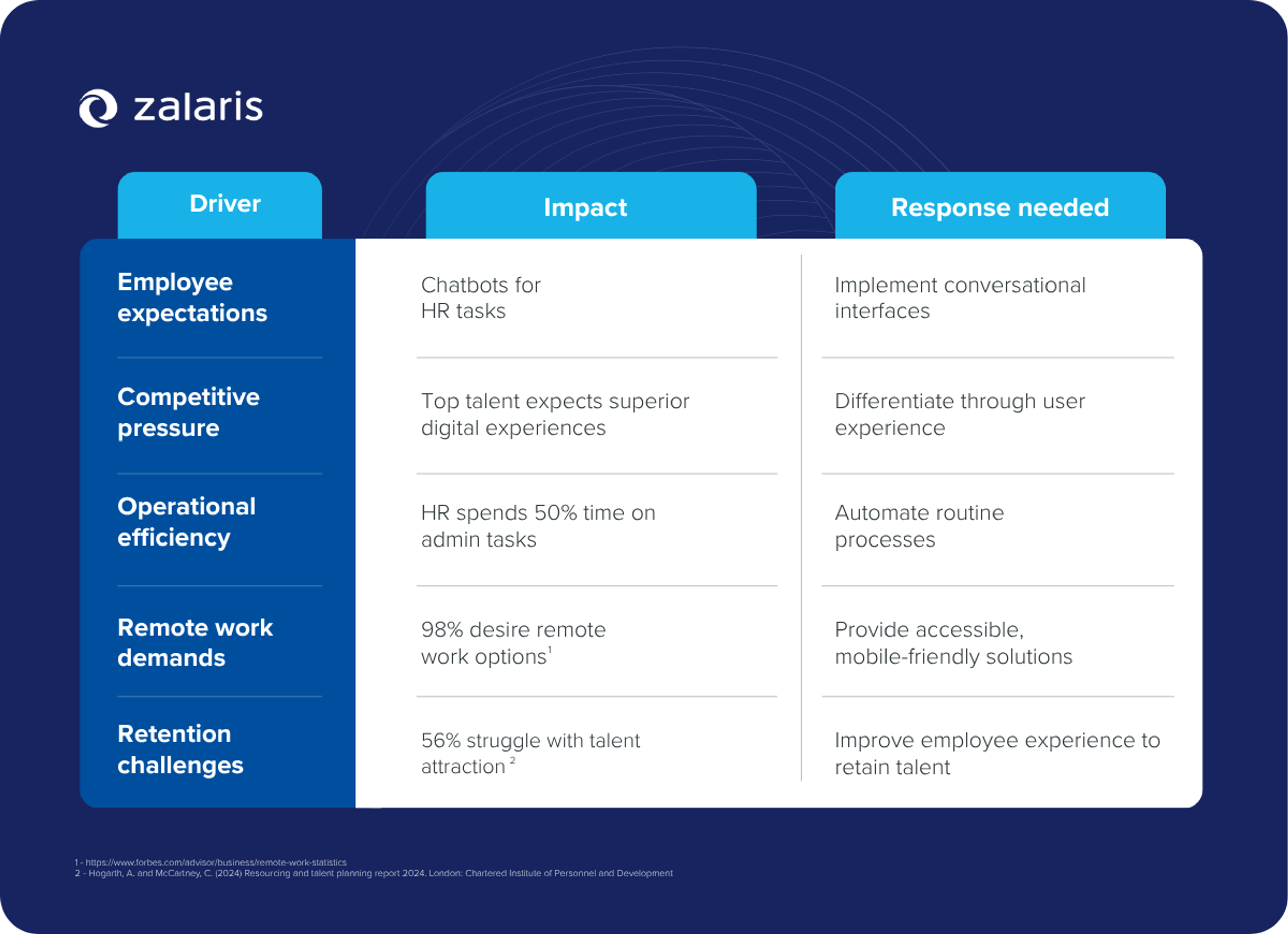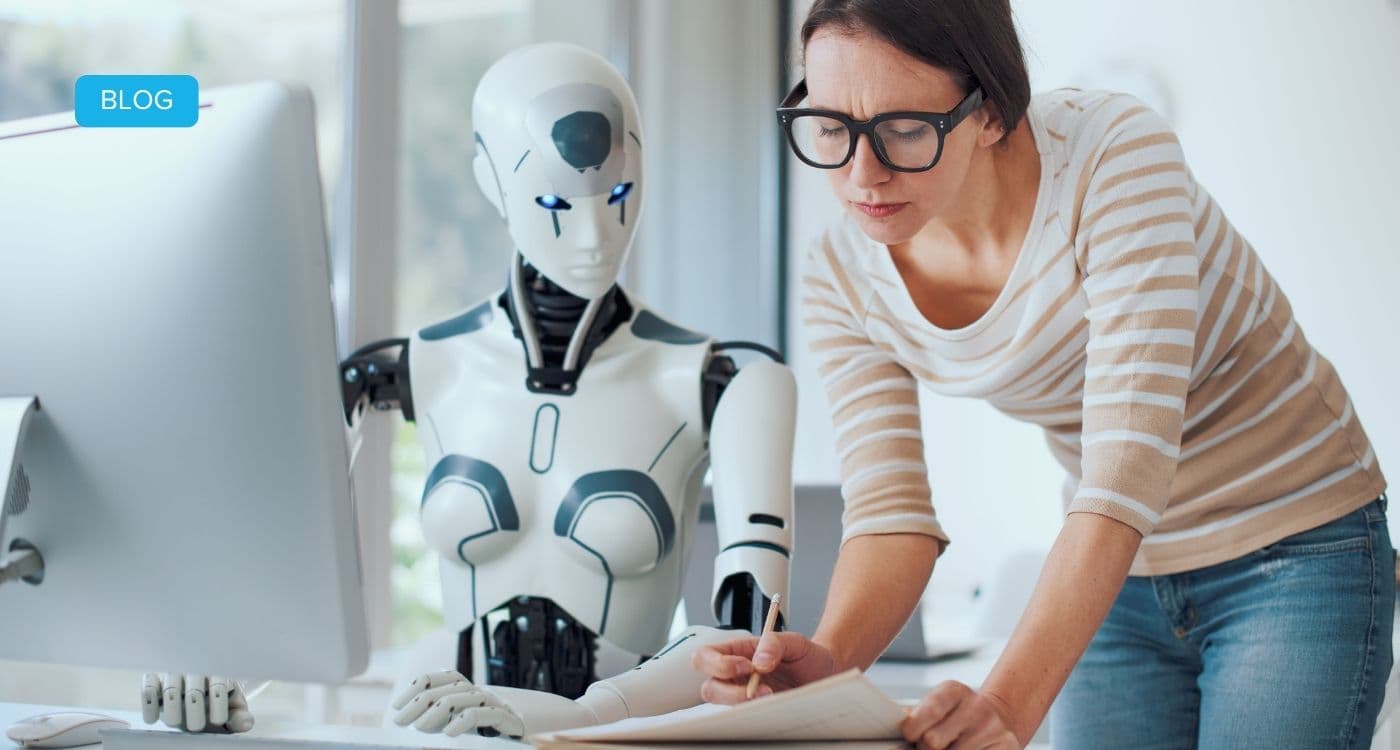From clicks to conversations: Why the future of HR experience is voice and chat driven
The era of endless form-filling and complex HR portals is ending. Organisations with hybrid workforces and rising employee expectations are witnessing a fundamental shift towards voice and chat-driven HR experiences that transform complex processes into natural conversations. This transformation is powered by conversational AI solutions and artificial intelligence, enabling more intuitive and efficient HR interactions.
Liam Clark

The numbers are compelling. The global HR technology market will grow from £28.8 billion in 2024 to £55.7 billion by 2033, with 62% of employees already preferring chatbots for HR tasks. By 2025, 8 billion AI-powered voice assistants will reshape workplace interactions. Conversational AI solutions and artificial intelligence are transforming human resources by automating various HR tasks, such as recruiting, onboarding, and employee engagement, making HR processes more efficient and user-friendly. This represents a shift from transactional, system-focused HR delivery to human-centered, conversational experiences.
The three pillars of conversational HR revolution
Intelligent automation: From manual to natural
HR professionals spend nearly half their time on administrative duties whilst employees wait for simple answers. Conversational AI changes this through intelligent automation, reducing HR helpdesk tickets and real-time, personalised responses that factor in employee location, tenure, and benefits package.
AI powered chatbots and virtual assistant technologies are key enablers of this shift, transforming how HR support is delivered. These tools automate routine tasks, handle repetitive tasks, and manage many HR tasks and HR related tasks, freeing HR professionals to focus on more strategic and human-centric responsibilities.
Traditional HR approach vs Conversational AI approach:
| Traditional HR approach | Conversational AI approach |
|---|---|
| Manual form completion | Natural language queries |
| Generic responses | Personalised, contextual answers |
| Business hours only | 24/7 availability |
| Single-channel access | Multi-platform integration |
| Reactive support | Proactive assistance |
Conversational AI streamlines the recruitment process by automating initial screening and initial screenings, allowing HR teams to efficiently evaluate candidates and improve the overall candidate experience. This technology transforms recruitment processes from manual to automated workflows, enhancing efficiency and integration with existing HR systems.
Advanced natural language processing enables systems to understand context and detect sentiment. When an employee asks about maternity leave, the system factors in their location, tenure, and benefits package for instant, tailored responses. Voice-enabled systems particularly benefit frontline workers in retail, healthcare, and manufacturing who can check schedules, request time off, or access training materials using voice commands while mobile.
Proactive employee support: Anticipating needs before they arise
Sophisticated HR systems now predict employee needs rather than simply react to problems. These systems use conversational AI to collect feedback and gather employee feedback through surveys and real-time interactions, providing valuable insights into employee sentiment and engagement.
Machine learning algorithms analyse communication patterns to identify early burnout signs and automatically identify skill gaps and advancement-ready employees. Analysing employee feedback allows organizations to boost employee morale by addressing concerns proactively and implementing improvements that enhance satisfaction and retention.
This predictive capability enables targeted interventions, personalised career conversations, and tailored retention strategies before issues escalate.
Seamless integration: Breaking down organisational silos
Conversational HR platforms integrate across organisational systems, providing employees with a single interface instead of multiple portals and login credentials. This includes connectivity across HRIS, payroll, learning management systems, and communication platforms like Slack, Microsoft Teams, and WhatsApp. Integrating HR tools ensures a seamless workflow by connecting essential systems, supporting automation, and enhancing employee support across multiple channels.
The integration enables sophisticated workflow automation. When an employee requests parental leave through voice command, the system automatically updates multiple systems, notifies managers, arranges coverage, and schedules check-ins. simple commands, whilst context switching elimination provides a single interface for all HR interactions.
The integration extends beyond internal systems to communication platforms where employees already spend their time. Modern HR chatbots, acting as virtual assistants, work seamlessly within messaging platforms, meeting employees in their natural workflow rather than forcing them to switch contexts. Virtual assistants enable employees to interact with HR across multiple platforms, improving accessibility and efficiency.
Zally: Pioneering the conversational HR experience at Zalaris
At Zalaris, we have experienced firsthand how conversational AI transforms HR service delivery through our intelligent chatbot, Zally. As an HR bot, Zally streamlines HR processes such as vacation requests and approvals by enabling employees to submit requests easily and allowing managers to efficiently approve or reject them through automation. More than just a question-answering tool, Zally represents a proactive, role-based assistant that fundamentally changes how employees interact with HR systems. Zally also helps new employees learn about company culture during onboarding by providing information about workplace values, policies, and fostering positive engagement.

Zally's advanced capabilities

Zally's proactive capabilities set it apart from traditional chatbots. Rather than waiting for employees to ask questions, Zally actively engages users with contextual reminders and notifications. When employees access the Zalaris PeopleHub portal, they immediately see whether Zally has active communications through colour-coded indicators.
The sophistication lies in Zally's contextual intelligence. The system understands that a payroll administrator needs different information than a new hire or department manager. Zally supports employee onboarding by guiding new hires and new employees through onboarding processes, sharing essential information, and providing virtual mentoring to ensure a smooth transition. Zally also provides up-to-date information about job openings, making it easy for employees and candidates to access available positions and details. Through ABAP programming, we have created a flexible framework that allows client-specific customisation while maintaining consistent, high-quality service across diverse organisational needs.
Key differentiators include:
- Contextual notifications such as missing time recordings with direct booking suggestions
- Role-based intelligence provides tailored information based on user responsibilities, while client customisation offers flexible scheduling and display rules.
- Seamless integration provides direct connection to People portal, SAP, and Travel & Expenses systems.
Perhaps most importantly, Zally demonstrates how conversational AI becomes smarter through interaction. Each conversation enhances the system's understanding of user needs, organisational patterns, and optimal response strategies. This continuous learning loop means that the more employees engage with Zally, the more valuable it becomes to the entire organisation.
The impact extends beyond efficiency metrics. By providing instant, accurate responses to routine queries, Zally frees HR professionals to focus on strategic initiatives like employee development, culture building, and organisational design. Employees report higher satisfaction with HR services, faster problem resolution, and greater confidence in accessing the information they need.

The strategic imperative: Why organisations must act now
The convergence of technological capability, employee expectations, and competitive pressure creates an urgent imperative for HR leaders to embrace conversational experiences. AI chatbots and AI powered chatbot solutions are transforming the hiring process, hiring processes, and recruiting processes by automating candidate engagement, screening, and communication. These technologies also reduce HR workload for the HR team and HR staff, allowing them to focus on strategic initiatives. The organisations that hesitate risk falling behind in the war for talent, as employees increasingly expect consumer-grade digital experiences in their professional lives.
Market drivers demanding immediate action

1 - https://www.forbes.com/advisor/business/remote-work-statistics
HR transformation is moving toward experience-led models, with conversational AI playing a central role in this evolution. Organisations implementing these technologies report not only operational efficiencies but also improved employee engagement, faster onboarding processes, and better retention rates. Chatbots help manage employee data securely, support employee morale, and empower employees by providing self-service options. Providing instant responses and scalable HR support is now essential to meet evolving HR needs.
The competitive advantage extends beyond internal operations. Companies with superior employee experiences become magnets for top talent, whilst those clinging to outdated, friction-filled processes struggle to attract and retain skilled workers.
Critical success factors include early adoption advantage to gain first-mover benefits before technology becomes commoditised. Employee satisfaction impact shows a direct correlation between digital experience quality and retention. Operational transformation requires a fundamental shift from reactive to proactive HR service delivery, whilst competitive differentiation uses superior employee experience as a talent acquisition tool.
Ready to transform your HR experience?
The age of AI has brought with it a fundamental reimagining of how organisations support and engage their most valuable asset: their people. Conversational AI is now enhancing human resource management and enhancing employee engagement across organisations. The companies that recognise this shift early and act decisively will build sustainable competitive advantages in talent acquisition, employee engagement, and organisational agility.
At Zalaris, we have built our HR capabilities on 25 years of deep HR and payroll expertise, serving over 1.5 million employees across 150+ countries. Our proven track record in HR transformation, combined with cutting-edge HR technology expertise, provides us a unique capability to help organisations such as yours navigate this critical transition.
The future of HR experience is conversational, proactive, and seamlessly integrated. The question is not whether this transformation will happen but whether your organisation will lead the change or struggle to catch up. Contact us today for a personalised demonstration of how our comprehensive HR solutions can transform your employee experience.
FAQ

Liam Clark
HCM Consultant
Liam is an HCM Consultant of Zalaris UK&I, with a technical and functional background of SAP Products. His current focus is on SuccessFactors Employee Central and Recruitment Modules. Before joining Zalaris at the start of 2021, he worked as a SAP HCM and Payroll Specialist within the UK Public Sector.
Table of Contents
- The three pillars of conversational HR revolution
- Intelligent automation: From manual to natural
- Proactive employee support: Anticipating needs before they arise
- Seamless integration: Breaking down organisational silos
- Zally: Pioneering the conversational HR experience at Zalaris
- Zally's advanced capabilities
- The strategic imperative: Why organisations must act now
- Market drivers demanding immediate action
- Ready to transform your HR experience?

